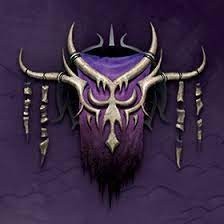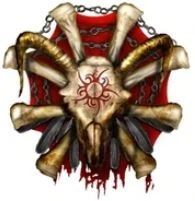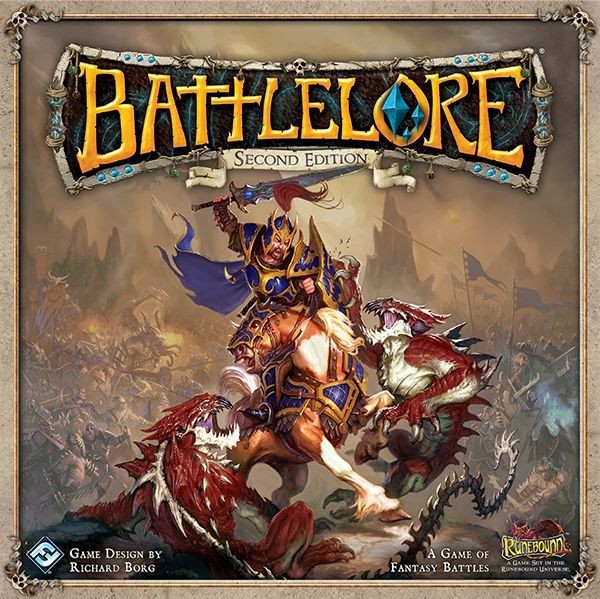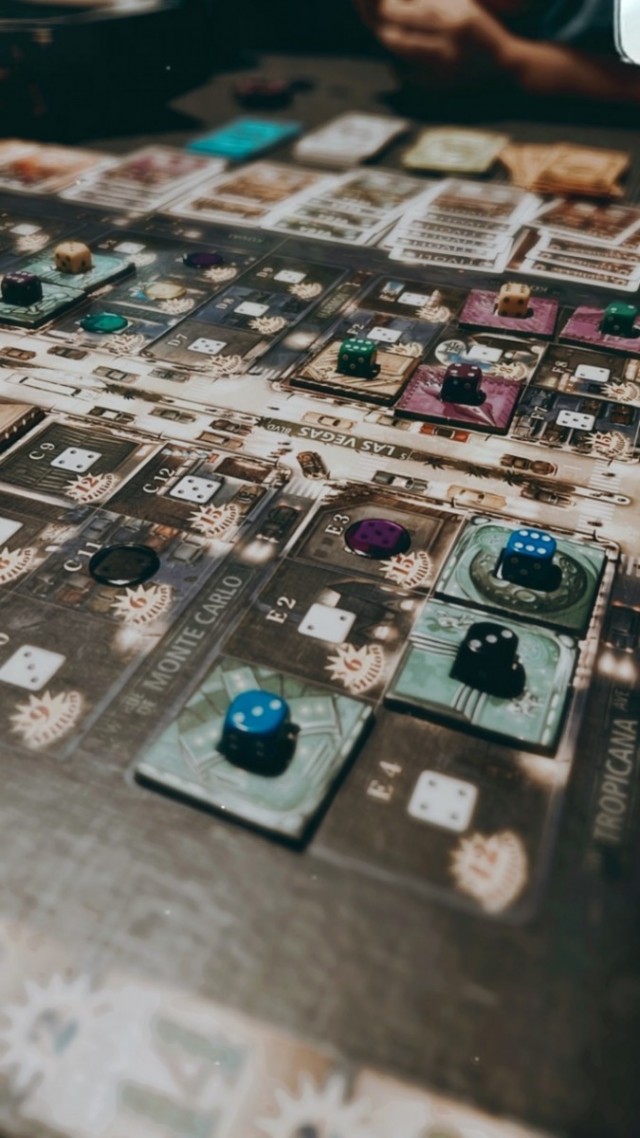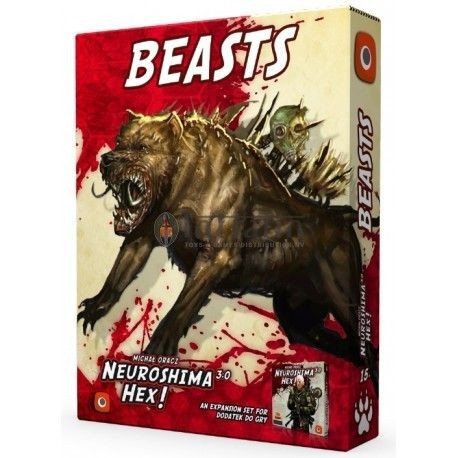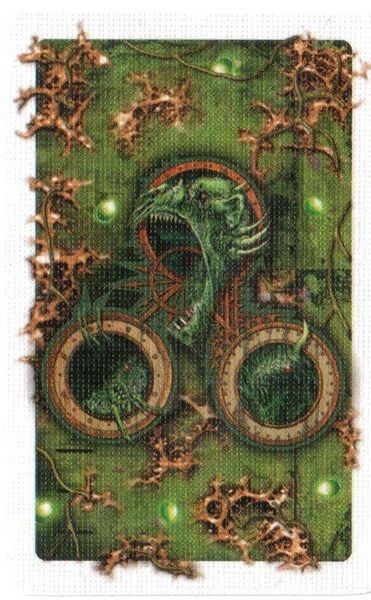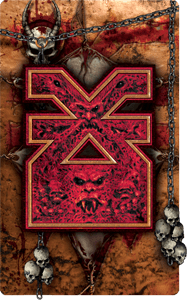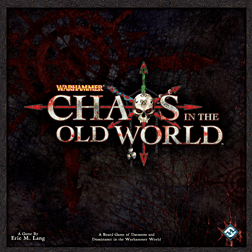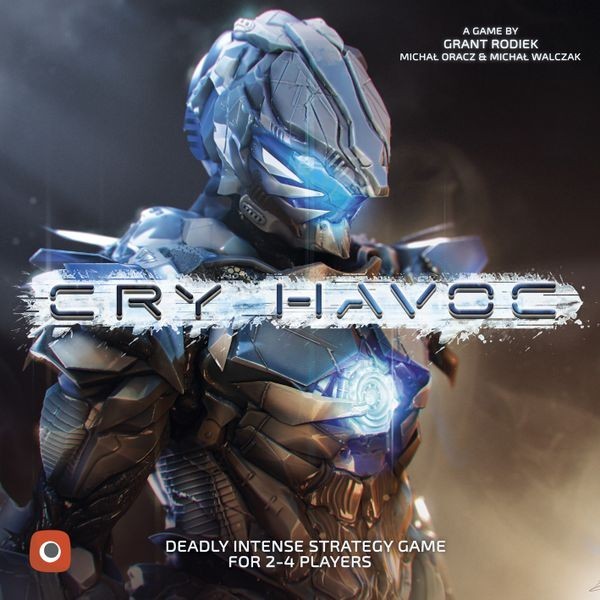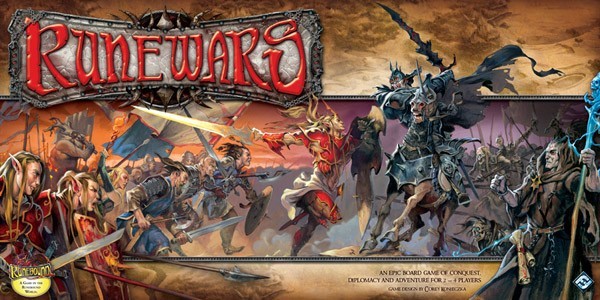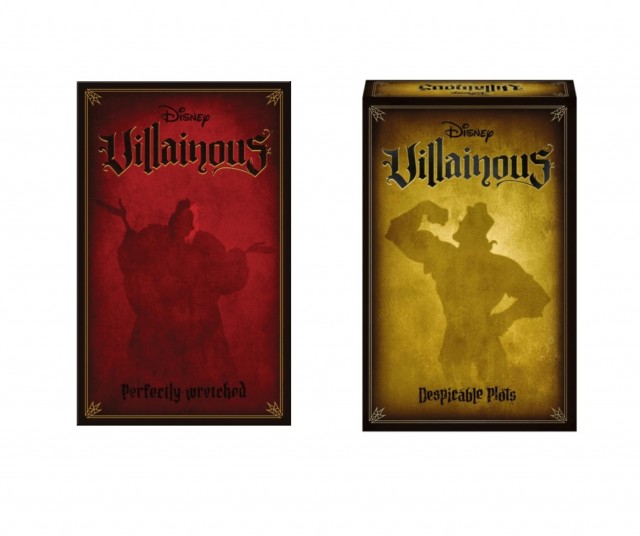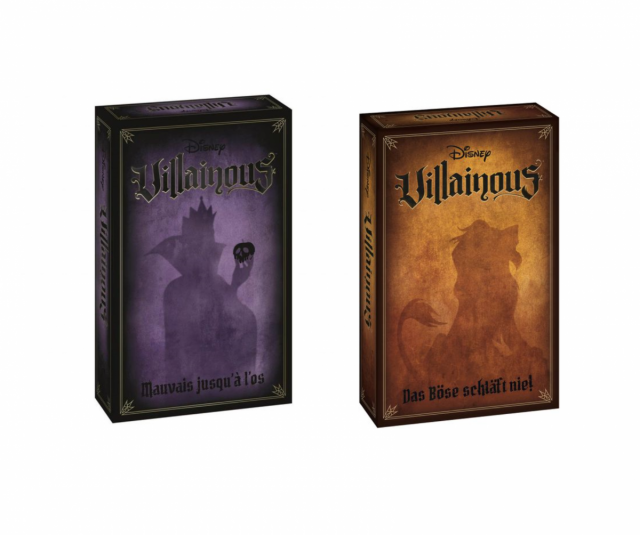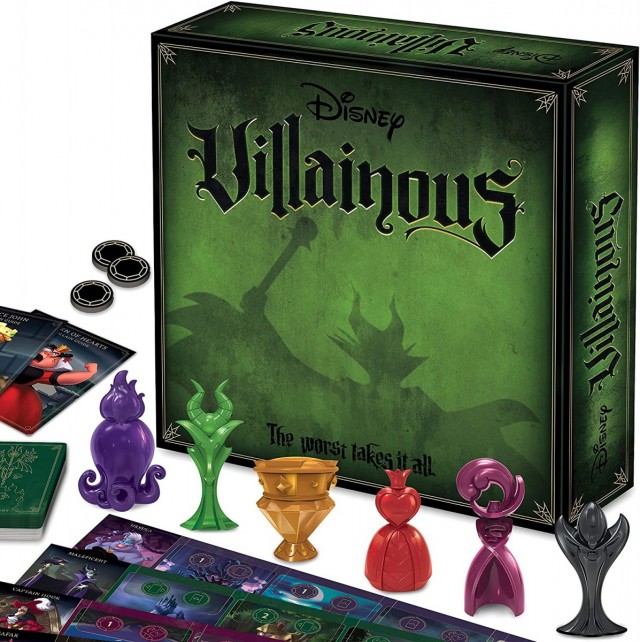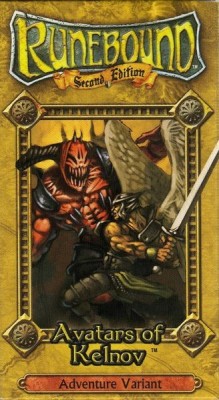The six small card expansions that change the story, plus the class cards.
There are multiple card expansions to Runebound. As mentioned in part 1, the majority of them are ways to fill out the Adventure decks of the base game and to increase the size and variety of the Market stack. However, six of them were intended to alter the experience of playing the base game, such that you'll still be tussling with Razorwings and Ferrox, but the background story won't be the quest to defeat High Lord Margath, but instead some other threat to the world of Terrinoth. Now, that sounds like you're just switching out one final boss for another and, indeed, a couple of them are like that. However, a few more are actually significant changes to the way various game systems work and make playing the base game a genuine departure from the norm.
Avatars of Kelnov: We'll start simply, since Avatars, despite being one of the last expansions for the game and more infused with already established lore, as it involves the Church of Kellos, is the most obvious example of "Here's a new boss; same as the old boss." In fact, Avatars strikes me as an idea that sat on the shelf as something that could be further enhanced and finally got tossed out late in the development cycle in order to fill a slot. It changes nothing about how the game is played, except for the fortunate occurrence of finding a couple green Encounters that can ward off the fairly deleterious effects of later yellow and blue Events. One of the blue Events, "The Crusades of a New Age", does require the players to pick sides between the priests of Kellos and the zealots attempting to return Kelnov to the world, but that's about as far as it goes in terms of flavor immersion. The red Challenges in the base game become useful runes when they're defeated. Similarly, the red Challenges in Avatar become items that are mostly tied to the actions of the other players (Gain life equal to the amount X player just inflicted, etc.), so there's a bit more of a PvP angle, but not a huge one. If you're searching for these expansions, it's safe to say that you could probably leave Avatars for last.

Crown of the Elder Kings: In contrast, Crown does the same thing, in that the base game isn't hugely affected, but the PvP aspect of the end game ends up front-and-center. Remember when you'd get the Crown of Command or Hercules' Belt in Talisman and the endgame would basically be you dueling the other players to knock them out? Same thing here. The experience progression technically "stops" with the blue challenges (red tokens are still present, as are the red cards if you want to win dragon runes) which are comprised of the houses of Secrets, Blood, and Hate. Each house is made up of four Vassals: A Knight, Knave, Lady, and Duke. The way to become the Elder King is to defeat and collect a set of any rank (3 of a kind) or 3 Vassals from any one house. At that point, you're the big dawg and every other player has to attempt to challenge you, one by one. They first have to fight your Vassals and then you (and any allies.) If they defeat any Vassals, they're discarded. However, they don't get to refresh between fights. It's a gauntlet, which makes it a fairly daunting task. If they defeat you, they become the Elder King and then anyone left in the game has to defeat them in similar fashion.
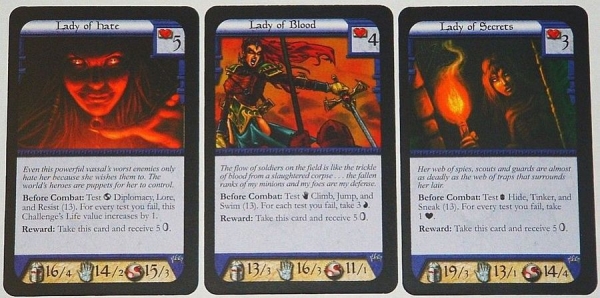
Crown is one of the more "mundane" scenarios in Runebound, in that it's mostly about gearing up to beat on each other. However, unlike many of the others, with the exception of four blue Events, Crown is made up entirely of Challenges: green and yellow, as well as blue. The green Challenges, such as the Guardian of Frostgate, allow you to make money off of other players using the Market step in the respective cities. Similarly, the yellow Challenges allow you to access items in different Market stacks for free. There is, of course, nothing wrong with that overall theme, but you have to make sure that your group is OK with a lot of direct confrontation because it's the only way to complete the game. If they're more interested in touring Terrinoth in service of some greater goal with the occasional "superhero meets superhero for the first time" scuffle, Crown may not be ideal for them. One option that Crown works really well with is the Class decks (see below.) Since those encourage (almost demand) player interaction to work well, they meld rather nicely with an endgame that is also about player interaction, as it were.
Scepter of Kyros: Like Avatars, Scepter is pretty much a direct swap for the ending of the base game and, like Crown, it delivers at the blue level, rather than at the red. What makes it one of the best of the small expansions is that its scope is broader than the base game. Instead of racing for those red tokens to try to find Margath, the endgame is a game-wide event. The Giant Lords descend from the north and occupy the cities of Terrinoth and then its on all the players to defeat them. What makes it even better is not only the variety of the 18 different Giant Lords, but that opposing players get to pick the stats for said giants based on the size of the occupied city's Market stack and they also get to use the items in that Market stack against the player trying to defeat them. This creates a series of really unusual opponents that is also a clock on the game itself. The longer the game goes on, the larger those stacks will be and, thus, the more difficult each Giant Lord will be. Since they are "only" blue Challenges, the temptation is to level past them and defeat some red Challenges and gain the dragon runes that those reds provide. But all you're doing is letting the giants accumulate more gear that they can later use against you. The winner is the player with the most fame points, which come from defeating Giant Lords, whether in the endgame or not. That makes Scepter a more contextualized experience, bringing it closer to the other three small expansions, which tend to tell more of a story than Avatars or Crown.
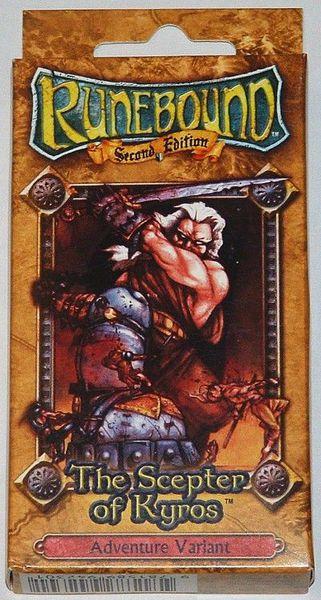
Like blue challenges in the base game and the other expansions, the Giant Lords often trade the raw power of red challenges for little quirks that make defeating them occasionally more trying than simply going in with all guns blazing against a dragon. Gort the Feral, for example, asks for a Tinker (12) test. If you fail, you get +2 to all your combat rolls against him. but you also can't use any items in the fight. Murphilious the Greedy imposes a penalty on all rolls against him equal to half of the gold you're carrying. Skerrin the Decomposing, meanwhile, takes no damage from any attacks. He simply takes a wound at the end of each round of combat. If you can last through four rounds, you win. Iuth the Soul Eater adds your allies' stats to his if he manages to kill one in combat, while Incantim the Runecaster reduces your damage values for each rune you possess; further encouraging you not to run around sweeping up red Challenges before taking on the Giant Lords. Scepter will always remain a favorite of mine among the game quests, if only for the way it requires you to adapt your approach. Also, why is it the "Scepter" of Kyros (Kyros is the most difficult of the giants, like Margath and Kelnov in their respective decks)? I don't know. It was released at the same time as Crown, so maybe they were going for a traditional theme (crown, scepter, orb), but there was never an "Orb of" something released.
The Cult of the Rune: In this expansion, a mysterious cult has taken root in the city of Forge and is spreading across the land. The players keep moving the cult marker around the map to show where the rituals take place that may end up "branding" their opponents (or themselves.) Suffering that treatment means you're weaker (-1 Health and Stamina) and must discard the VPs for this scenario, which are defeated Rune cultists; that is, until you're willing to sacrifice some XP in order to get rid of the brand and continue on your adventuring way. The scenario does a good job not only of containing the game time in one of a number of ways (cycling through the regular deck Encounters and Events, defeating a certain number of cultists, etc.), since there is no One Big Enemy to defeat, but also in encouraging interaction with the scenario challenges. Since you win by being the one to knock out the most members of the cult, you can't just do an end run around the events taking place and win by being the biggest kid on the block. The designers did a nice job of using the components and cards of the base game to make it function in a different way (i.e. the normal Doom counters become Corruption markers, etc.)

Given the victory conditions and similarly to Crown, the Cult deck is made up entirely of Challenges. The one downside to Cult is that the abilities of many of the challenges are fairly routine. Several of the blue Challenges get bonuses in attack phases where they're either attacked or your hero is defending or an ally is doing the same. All of the red Challenges receive a stat increase of some kind based on the number of red cultists you've already defeated. There are some interesting foes, such as the Mist Weaver, which requires a Spot (16) test. If failed, you have to roll a terrain die for each ranged or melee attack and rolling a river icon means the attack fails, regardless of number; or the Night Witch, who requires either a -4 combat penalty or a -1 damage penalty in every phase. But most of the opponents are pretty straightforward. It strikes me that the cult interfering in the Market step in the cities that they infest would also have been a worthwhile addition to the whole scenario, but it's possible that the designers felt that was too much change for a small expansion (except, well... wait until we talk about The Cataclysm...)
The Seven Scions: Scions almost seems to be an expansion designed with the experienced Runebound player in mind. It's part of the last cycle of small expansions, so that may be what they were aiming for. There's a tighter setup, in that only a number of Storm cards equal to the number of players are added to the game. Storm cards are also resolved against everyone in the Storm step (appropriately.) The tests from the Events are significant and the Challenges are somewhat more difficult than the normal green, yellow, and blue cards. Furthermore, the rewards are simply recovery. You get Health and Stamina back, but no cash or other bonuses. Plus, the experience only goes to the player who triggered the Adventure. So, you're going to have to make do with what you can pick up outside of the Storm cards and still take the beating from them, win or lose. Assisting you in that respect are the Seven Scions.
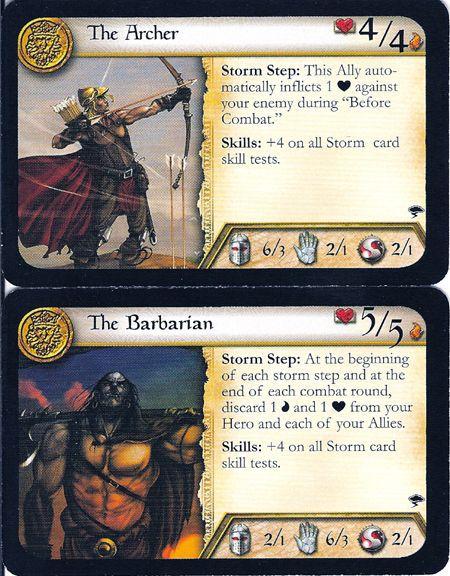
The Scions are decent, one-time bonus cards when slumbering (+3 to a trait, reduce damage, etc.) They get reshuffled and selected again during each Storm step. When awakened, which can only happen with a player on a red jewel and fulfilling a pretty rigorous condition, they turn into solid allies for any subsequent Storm steps, such as against the silver Storm Lords (Dragon Lords, Giant Lords... there'a a theme here) during the endgame. They're kind of important against some of the Lords, like Syraskil, who doubles the wounds on your hero and all allies at the end of each round, or Chakinto, who heals to full every time he's attacked (i.e. you have to one-shot him.) But otherwise the Scions are just kind of hanging around (Thankfully, they don't take up an ally slot.) So, you're essentially playing base Runebound with an additional condition layered over the top which generally makes the game more challenging. If that sounds like a "more chrome than necessary" (MCTN) condition, then you're not alone. I like Scions for the ideas behind it and the story concept, but I think the execution made it more of a shell on top of a game than a part of the game itself. There's also a cooperative approach to this expansion if you have a group that enjoys co-ops and would like to team up to challenge the Storm Lords at the end, a la Arkham Horror.
The Cataclysm: This one is my favorite of the small expansions, if only for the extent to which it transforms the normal gameplay. When it begins, 3 of the 8 cities in Terrinoth are destroyed. Just, y'know... gone. Like in a cataclysm. Even worse, the other 5 are cursed by some malevolent spirit and can't be used the way cities normally are (Market steps, etc.) To get around, get healed, and get lootz, you have to divide up your movement dice into a travel pool and a trading pool. The travel pool lets you move around like normal. The trading pool requires you to roll terrain symbols that match your location in order to get healing and/or buy/sell from the Market deck. According to the rules, you're basically depending on small homesteads and caravans to get by. (That makes using the Bazaar rules kind of incongruous, so we've abandoned them in the times we've played this scenario, which ramps up the difficulty somewhat, but enhances the post-apocalyptic atmosphere.) The goal in this scenario is to free the cities from their respective curses. When you do, you can use the Market step normally again. Whoever has the most points in Curse cards at the end of the game, wins.
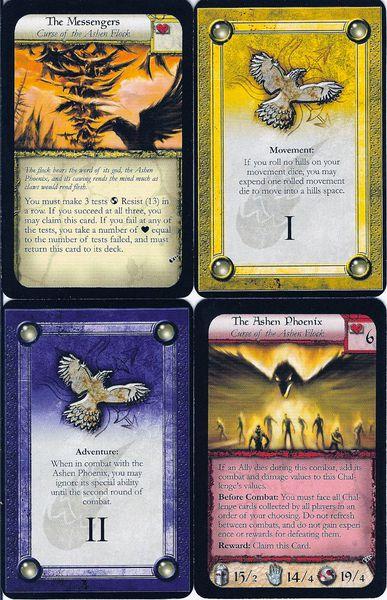
Remember me bemoaning the fact that the names on the map don't mean anything? Well, this is the only small expansion that takes that into account, as the blue level Curse cards require you to travel to different points on the map and complete various tests and tasks before returning to claim that card and open the possibility of taking on a red Curse card and freeing a city. So, finally the Hanging Wood has a purpose other than just being a bunch of forest spaces with some adventure tokens. This expansion also gets points for the heavy amount of lore. Margath is mentioned throughout one of the Curse decks (Curse of the Savage Brood), but the Crown of the Elder Kings is also mentioned, and the priesthood of Kellos is prominent in the Curse of the Frenzied Rage (one Challenge gets ignored if you have any allies/items that have the word "Kellos" on them.) The red Curse cards are really quite difficult so, like Seven Scions, I think Cataclysm is intended for experienced Runebound players, as you may have already guessed from the increased difficulty in just walking around and/or getting healed.
The Class decks: These card expansions were a matter of some contention among my regular group and Runebound fans, as a whole. What they do is basically make Runebound into more of a competitive game than it already is. Instead of occasionally poking your opponents with Encounters or ambushing them outside Vynelvale to acquire that Rage Blade that they just bought, the class decks encourage you to threaten or impede your opponents at every opportunity. They do this through the Menace system. Each player has 10 Menace tokens. As you play positive cards on yourself from your Class deck, you add tokens to your pool. As opponents play negative cards on you, they remove tokens from your pool. You can't play more positive stuff if you're maxed at 10. They can't play negative stuff on you if the Menace cost of their card is greater than the tokens you have to remove. So, it's a pretty simple balancing system that doesn't allow players to get battered early in the game before they've had a chance to boost themselves. It also doesn't allow players to get dog-piled by opponents, especially since the more powerful cards in all the decks have an Epic symbol and only one Epic card can be played per player turn. All of the decks are split into Feats, Spells, and Locations (can normally be played on you or an opponent), Challenges (played on an opponent), and five Talents, which you earn by paying XP, rather than doing the normal level up process.
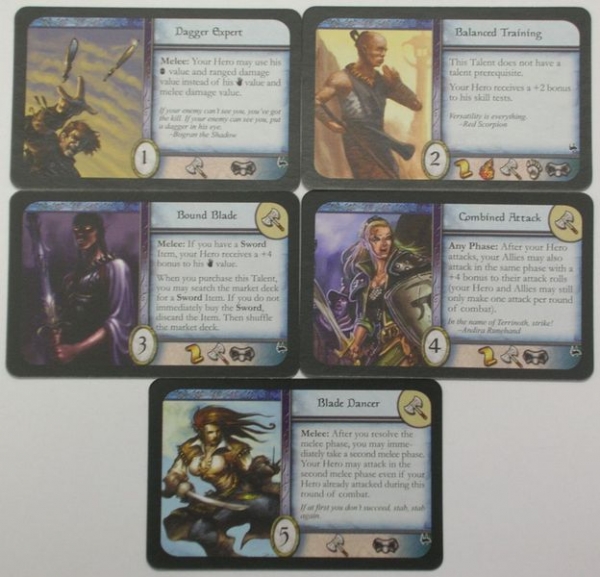
While the decks did add yet another layer of chrome to the game, the system itself isn't very complicated. If you could play Arkham Horror with a couple expansions, you could add these without impinging on time limits in any tremendous fashion. They also potentially ramped up the power level of heroes in the game significantly, so the acceleration of leveling and facing greater challenges counteracts the time load of having a hand of cards to pay attention to. The counterpoint, of course, is that there are also a greater variety of attacks and tests coming your way as a player and these are planned by other humans, rather than a cardboard system, so being overwhelmed isn't beyond the realm of reason. IMO, the Blade Dancer was head-and-shoulders above the other five decks (Battlemage, Runemaster, Shadow Weaver, Spiritbound, Wildlander) but all of them had some good tricks and added some variety to the game. If you were into the PvP aspect of the game, they're a worthy addition. For much more on them, I wrote a detailed review on BGG 14(!) years ago at Octavian's request.
So, those are the small expansions, which run the gamut from fairly forgettable to really quite interesting and challenging. If you wanted some decent alteration to your regular Runebound play, they were certainly worth the cost at the time ($8, IIRC.) In part 3, I'll dive into the real magical difference in Runebound play: the large expansions.
 Games
Games How to resolve AdBlock issue?
How to resolve AdBlock issue? 